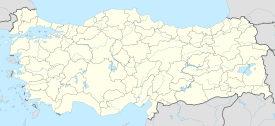Çatal Höyük

Çatalhöyük at the time of the first excavations
|
|
| Location | Küçükköy, Konya Province, Turkey |
|---|---|
| Region | Anatolia |
| Coordinates | 37°40′00″N 32°49′41″E / 37.66667°N 32.82806°ECoordinates: 37°40′00″N 32°49′41″E / 37.66667°N 32.82806°E |
| Type | Settlement |
| History | |
| Founded | Approximately 7500 BCE |
| Abandoned | Approximately 5700 BCE |
| Periods | Neolithic to Chalcolithic |
| Official name | Neolithic Site of Çatalhöyük |
| Type | Cultural |
| Criteria | iii, iv |
| Designated | 2012 (36th session) |
| Reference no. | 1405 |
| State Party | Turkey |
| Region | Europe and North America |
Çatalhöyük (Turkish pronunciation: [tʃaˈtaɫhøjyk]; also Çatal Höyük and Çatal Hüyük; from Turkish çatal "fork" + höyük "mound") was a very large Neolithic and Chalcolithic proto-city settlement in southern Anatolia, which existed from approximately 7500 BC to 5700 BC, and flourished around 7000 BC. In July 2012, it was inscribed as a UNESCO World Heritage Site.
Çatalhöyük is located overlooking the Konya Plain, southeast of the present-day city of Konya (ancient Iconium) in Turkey, approximately 140 km (87 mi) from the twin-coned volcano of Mount Hasan. The eastern settlement forms a mound which would have risen about 20 m (66 ft) above the plain at the time of the latest Neolithic occupation. There is also a smaller settlement mound to the west and a Byzantine settlement a few hundred meters to the east. The prehistoric mound settlements were abandoned before the Bronze Age. A channel of the Çarşamba river once flowed between the two mounds, and the settlement was built on alluvial clay which may have been favourable for early agriculture.
The site was first excavated by James Mellaart in 1958. He later led a team which excavated there for four seasons between 1961 and 1965. These excavations revealed this section of Anatolia as a centre of advanced culture in the Neolithic period.
Mellaart was banned from Turkey for his involvement in the Dorak affair in which he published drawings of supposedly important Bronze Age artifacts that later went missing. Excavation revealed 18 successive layers of buildings signifying various stages of the settlement and eras of history. The bottom layer of buildings signifies as early as 7500 BC while the top layer is of 5600 B.C.
...
Wikipedia

